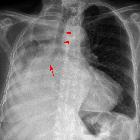Krukenberg tumor


















Krukenberg tumor, also known as carcinoma mucocellulare, refers to the "signet ring" subtype of metastatic tumor to the ovary. The colon and stomach are the most common primary tumors to result in ovarian metastases, followed by the breast, lung, and contralateral ovary.
Epidemiology
The tumors represent 5-10% of all ovarian tumors and up to 50% of all metastatic tumors to the ovary. The estimated incidence of Krukenberg tumor is at approximately 0.16/100000 per year. They tend to develop during the reproductive years .
Clinical presentation
Abdominal or pelvic pain, abdominal bloating, or pain during intercourse, may be the presenting symptom. Irregular bleeding may also be seen.
Median patient age at presentation is 48 years.
Pathology
Krukenberg tumors are metastatic tumors to the ovary that contain well defined histological characteristics - mucin-secreting “signet ring” cells and usually originate in the gastrointestinal tract .
The time from diagnosis of the primary neoplasm to the development of ovarian metastasis is variable and can range from several months to >10 years.
Cytologic examination often reveals mucoid degeneration and many large cells shaped like signet rings.
They can originate from :
- stomach cancer (signet-ring cells): most common
- colorectal carcinoma: second most common
- breast cancer
- lung cancer
- contralateral ovarian carcinoma
- pancreatic carcinoma
- cholangiocarcionoma/gallbladder carcinoma
Radiographic features
Most imaging features are non-specific, consisting of predominantly solid components or a mixture of cystic and solid areas. It is often difficult to differentiate from other ovarian neoplasms . There are a variety of metastatic carcinomas to the ovary that can mimic primary ovarian tumors .
Pelvic ultrasound
These tumors are typically seen sonographically as bilateral, solid ovarian masses, with clear well-defined margins. An irregular hyper-echoic solid pattern and moth-eaten like cyst formation is also considered a characteristic feature.
CT
CT appearances can be indistinguishable from primary ovarian carcinoma . Features will favor towards a Krukenberg tumor if a concurrent gastric or colic mural lesion is seen. There is some evidence that tumors originating from the stomach may be denser on contrast-enhanced CT than those originating from the colon .
Pelvic MRI
The great majority of Krukenberg tumors are signet-ring cell carcinomas arising in the stomach. Signet-ring cells scatter in the ovarian stroma with abundant collagen formation or marked edema. Therefore, Krukenberg tumors can occasionally show low or high signal intensity on T2-weighted images .
Krukenberg tumors may demonstrate some distinctive findings on MRI, including:
- bilateral complex masses with hypo-intense solid components (dense stromal reaction)
- internal hyperintensity (mucin) on T1 and T2 weighted MR images
Strong contrast enhancement is usually seen in the solid component or the wall of the intratumoral cyst .
Treatment and prognosis
Differentiation between primary and metastatic ovarian carcinoma is of great importance with respect to treatment and prognosis but may be very difficult based upon imaging findings solely.
Median survival
Median overall survival is of the order of approximately 16 months . The breakdown by primary tumor location is as follows :
- gastric: 11 months
- colorectal: 21.5 months
- breast: 31 months
- other (appendix, gallbladder, small intestine, unknown): 19.5 months
Associated factors for poor prognosis and predictors of unfavorable outcome include :
- univariate analysis
- synchronous metastasis
- no chemotherapy
- ovarian metastasis beyond the pelvis
- multivariate analysis
- synchronous metastasis
- pelvic invasion
- ascites
- no metastasectomy
History and etymology
It is named after Friedrich E. Krukenberg, German pathologist (1871-1946) who first described them in 1896.
See also
Siehe auch:
- Lungenkarzinom
- Gallenblasenkarzinom
- Pankreaskarzinom
- Kolorektales Karzinom
- Neoplasien des Ovars
- Adenokarzinom des Magens
- cholangiozelluläres Karzinom
- Ovar
- Metastasen des Ovars
- Neoplasien der Mamma
- Abtropfmetastasen
- solid mass of the ovary
- primary ovarian carcinoma
und weiter:

 Assoziationen und Differentialdiagnosen zu Krukenberg-Tumor:
Assoziationen und Differentialdiagnosen zu Krukenberg-Tumor:








